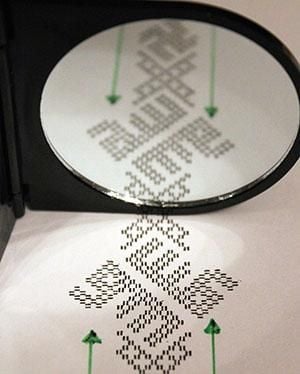Did Vikings Bury Their Dead in Clothing Bearing the Arabic Word for “Allah”?
While contact between Vikings and Muslim cultures is well documented, the interpretation of the 10th-century burial cloth has been called into question
/https://tf-cmsv2-smithsonianmag-media.s3.amazonaws.com/filer/62/cc/62ccd971-6a6e-49aa-a68d-e5f1bec2b58b/brickvavda_band_6302.jpg)
Editor's note, October 16, 2017: Stephennie Mulder, an associate professor of Islamic art and architecture at the University of Texas at Austin, has called the interpretation of the Viking textile into question. On Twitter, she explains that while Vikings "had rich contacts" with the Arab world, the textile, which dates to the 10th century, uses square Kufic, a style of epigraphy that is not known to exist for another three centuries. In the thread, she adds that even if square Kufic tablet weaves were used, the text reads له ‘lllah’ not "Allah," which, she writes, "basically makes no sense in Arabic." This story is developing.
When textile archaeologist Annika Larsson of Uppsala University first saw the intricate patterns laced in silver and silk thread on the burial garments of Vikings, she didn't know what they signified. But their shapes tugged at her memory.
"I couldn't quite make sense of them and then I remembered where I had seen similar designs — in Spain, on Moorish textiles," she tells Tharik Hussain, reporting for BBC. She realized that the patterns weren't just geometric designs, but Arabic Kufic script, developed in the 7th century and one of the first Arabic scripts used to write the Koran.
Larsson was working with a team of researchers to recreate textile patterns for the Viking Couture exhibit at the Enköping Museum in Sweden. To investigate the odd occurrence of Arabic script on Viking clothing, the team enlarged the patterns and examined them from many angles, including from behind. This at last revealed the word "Allah," or God, stitched in mirrored lettering. The name "Ali" was also repeated, a reference to the fourth caliph of Islam who is revered by the Shia, the largest Muslim minority group.
"Perhaps this was an attempt to write prayers so they could be read from left to right, but with the Arabic characters they should have," Larsson says in a press release from the university.

This isn't the first time that researchers have uncovered evidence for a connection between the Vikings—who enjoyed great influence in Europe from late-8th century through the mid-11th—and the Islamic world, according to Martin Belam at The Guardian. More than 100,000 Islamic silver coins have been found in Viking-age Scandinavia. Researchers uncovered objects related to Islam, Christianity and the worship of Thor at the Vale of York Viking hoard in 2007. And a Viking woman's ring found in 2015 has an inscription reading "for Allah" or "to Allah."
"That we so often maintain that Eastern objects in Viking Age graves could only be the result of plundering and eastward trade doesn’t hold up," Larsson says in the press release.
Instead, the discoveries offer evidence of contact and the influence of Islam on Viking customs, writes Austa Somvichian-Clausen for National Geographic. Larsson's earlier research has detailed how common it was for Eastern artifacts to appear in Viking-age graves, suggesting burials were shaped by Islamic traditions. It's also possible that some people in Viking-era graves were Muslim.
The most novel part of the finding is the name "Ali," the first time it has appeared on artifacts from Scandinavia.
The name offers a tantalizing but enigmatic clue. "The use of Ali does suggest a Shia connection," Amir De Martino, program leader of Islamic studies at the Islamic College in London, tells the BBC. But the pattern appears without the phrase "waly Allah," or "friend of Allah," a discrepancy that could be a simple mistake — lost in translation from one culture to another.
The textiles, reconstructions and more are one view as part of the Enköping Museum's Viking Couture exhibit running through early February 2018.